For three years now, we’ve asked our network of 500+ solar installers what brands of solar panels they’d choose to install on their own homes.
We ask which brand they’d choose if ‘money were no object’ and the brand they’d go for if they were on a tight budget and ‘every dollar counts’.
The idea is to discover the solar panel brands the installers rate in two important categories:
- The best solar panels, full stop.
- The best value solar panels.
For 2023, I added a third category:
- The brand with the best Australian after-sales support.
Good support means: if anything goes wrong over the multi-decade warranty, the installer will get prompt and fair warranty service, which means any failed panels are replaced faster and with less hassle.
Here are the results1 for the SolarQuotes 2023 Installers’ Choice Awards :
Best Solar Panels In Australia: 2023
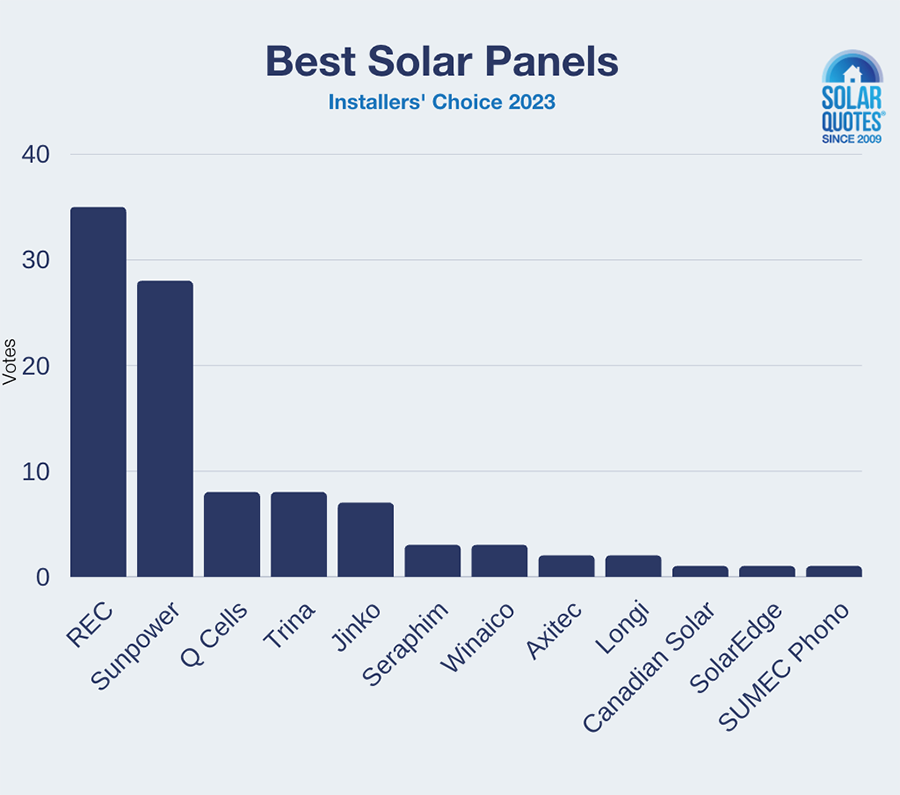
There are two solar panel brands way ahead of everyone else…
Best Solar Panels 2023: REC
REC scored bronze in 2021 and silver in 2022; finally achieving gold in 2023 with 36% of all votes.
Funnily enough, I have 14kW of REC Alpha Pure 410W panels on my roof, installed in late 20222. I chose them for their energy density – I wanted to fit as many kilowatts as possible on my north-facing roof – and I also liked their warranted low-degradation.
Since my installation, REC has released their Alpha Pure R series, which are even more energy dense – up to 430W in a 1.1 x 1.7m all-black panel and an efficiency of 22.3%.
Alpha Pure R’s other specs are also fantastic:
One thing I really like about all REC solar panels is their two extra framing struts. A panel that flexes less will last longer and have less stringent clamping zones. It’s great to see a solar panel manufacturer that is not afraid to beef up the often scrawny frames:
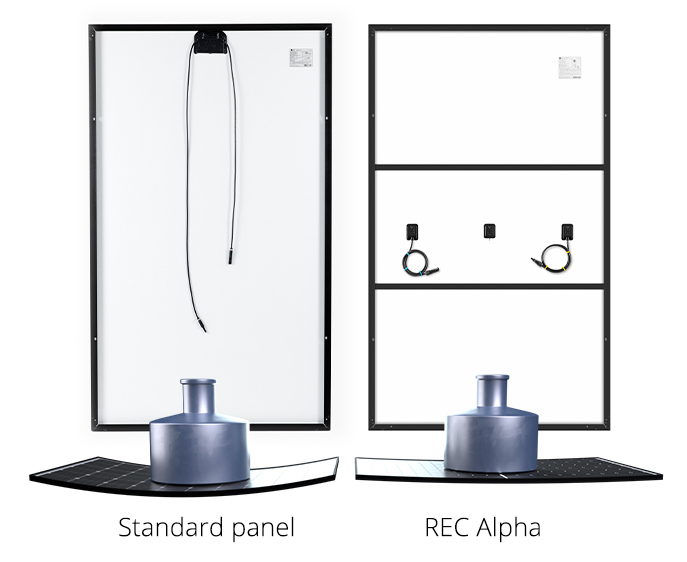
Note: REC use the reinforced frame style on all their panels, not just the Alphas.
Our REC solar panel reviews give a 4.8 star average from 779 reviews (4.9 star average in the last six months), and here’s a recent comment:
“I’m surprised by the level of electricity still generated even in overcast and rainy conditions. Not being a high-power consumer, it has been enough in those conditions for my home to run during the day.”
My experience concurs, with impressive power output at dawn and dusk.
REC Alpha Pure R modules retail for about $1 per watt5.
Best Solar Panels 2023: Second Place – SunPower
SunPower lost their 2022 top spot despite winning an impressive 29% of all votes.
In my opinion: although SunPower panels are fantastic, it can be hard to justify the price premium for their flagship Maxeon panels – unless you want the insane 40-year product warranty and factory-installed Enphase microinverters.
How do SunPower’s key specs compare to REC? Compared to REC’s Alpha Pure R, the SunPower Maxeon 6 panels are:
- 22.8% efficient, 0.5% better than the best REC
- 0.25% warranted annual degradation, same as REC
- -0.29% / °C Temp coefficient of Pmax, 0.03 worse than REC
- 40-year product warranty – 15 years longer than REC
Interestingly, SunPower (Maxeon) is one of the only panel manufacturers who have not transitioned to half-cut solar panels, preferring their whole-cell technology – each beermat-sized wafer sitting on a slab of expensive and robust copper.
Our SunPower reviews show an average score of 4.8 stars from 863 reviews (4.9 in the last six months). Here are two recent comments from Australian reviewers:
“Bought the Maxeon 6 for their 40 year warranty and reliability, even though they cost more. This is an installation to last me through my retirement so I wanted to do it just once.”
“These black panels with integrated Enphase micro-inverters look nice on the roof and also fitted our small and articulated roof well. The panels have been installed for a month now and I am happy with the production which meets up with what was predicted with the quotes.”
Sunpower Maxeon 6 solar panels with built-in Enphase microinverters retail for about $1.74 per watt. That’s about $1.23 per watt for just the panel (with the cost of the microinverter removed).
Best Solar Panels 2023: Joint Third Place – Qcells / Trina
Qcells and Trina Solar share the third spot. Qcells were third last year, whereas Trina has climbed from 8th place in 2022.
Qcells has three ‘tiers’ of solar panels – the Q.PEAK series, their flagship product made in South Korea. Then there’s the Q.BOOST series, their midrange offering made in Malaysia, and the Q.MAXX series, Qcells’ most affordable panel made in China.
I believe many installers favour Qcells because of their range – there’s something for every customer’s price point, and they’re all backed the same.
Qcells reviews have an average score of 4.8 stars based on 1245 reviews. One recent customer review:
“We thought we would go with a better brand of panels and the Qcells surely didn’t disappoint. Great all round system.”
Qcells flagship Q.Peak panels are up to 21.1% efficient; with these key specs:
- 0.5% warranted degradation
- -0.34% / °C Temp coefficient of Pmax
- 25-year product warranty
…and retail for about 90c per watt.
Trina, meanwhile, only makes its panels in China (and boy, does it make a lot of them – around 50GW of panels in 2022, compared to Qcells’ ~12GW), and they all sit around the same price point.
Trina Solar’s reviews on SolarQuotes score 4.8 from 1,596 reviews (4.9 in the past six months). One recent reviewer told us:
“Its hard to tell this early, but now in summer they always produce max output and surprisingly high on cloudy days which struck me as amazing.”
Trina Vertex S solar panels are up to 21.8% efficient with:
- 0.55% warranted degradation
- -0.34% / °C Temp coefficient of Pmax
- 25-year product warranty
…and retail for about 60c per watt.
Best Value Solar Panels In Australia 2023
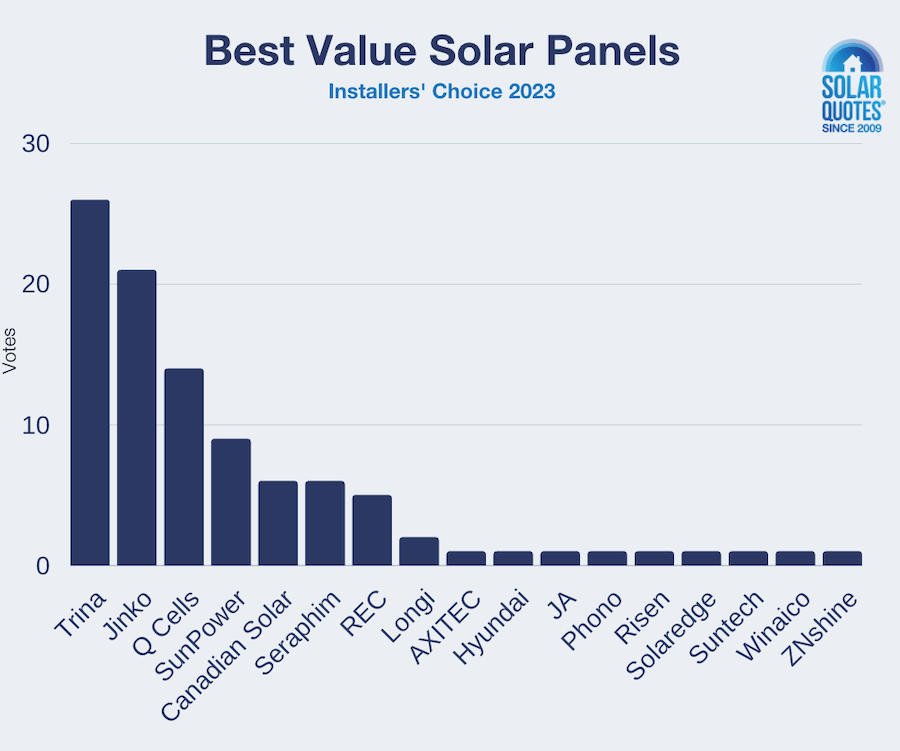
A more even spread of votes than the ‘best solar panels’ poll.
Best Value Solar Panels 2023: First Place – Trina
Trina is still the undefeated king of great value solar panels, having won this category in 2021 and 2022.
Winning third in ‘best solar panel’ and first in ‘best value panel’ is a vote of confidence in Trina and its Australian operation6.
As mentioned, Trina Vertex S panels retail for about 60 Australian cents per watt.
Best Value Solar Panels 2023: Second Place – Jinko
Hanging on to second place in the ‘best value solar panel’ category for the third year in a row is Jinko Solar.
Jinko’s Tiger Pro panel is up to 20.77% efficient with:
- 0.55% warranted degradation
- -0.35% / °C Temp coefficient of Pmax
- 25-year product warranty
Jinko reviews give an average score of 4.8 from 2036 reviews (4.9 in the past six months), and one reviewer recently updated us on his decade-old install:
“I have 13 Jinko Panels installed at my old house for 10 years – absolutely trouble free.”
Expect to pay about 60c per watt retail for Jinko solar panels.
Best Value Solar Panels 2023: Third Place – Qcells
Qcells keep their third place from 2022. Their cheaper Q.MAXX and Q.BOOST panels are more expensive than Trina and Jinko’s, with almost identical specs:
- 0.5% warranted degradation
- -0.35% / °C Temp coeffient of Pmax
- 25-year product warranty
Q.MAXX solar panels retail for about 75c per watt.
Solar Panels: Best After-Sales Support
Good support with a solar panel means the installer gets a fair and prompt response when they file a warranty query.
Here are the results – all familiar names by now!
With REC winning both the ‘best panel’ and ‘best support’, I’m feeling warm and fuzzy that I chose them for my own roof six months ago. Well done, REC!
If you are thinking of a new or upgraded solar power system for your home – any of these award winners is a safe bet. If you are wondering whether to go premium or more budget, it comes down to energy density, degradation and personal preference.
If you want higher energy density, low annual degradation and the best possible high-temperature power output – and don’t mind paying for it – REC or SunPower is for you.
If you are on a budget and happier with a little less energy density, a little less energy on hot days and a bit more performance loss over the years, any of the budget solar panels on the podium should give you decades of cheap electricity in the harsh Australian sun.
See SolarQuotes recommended solar panel brands here.
Also check out: SolarQuotes Installers’ Choice Awards 2023 – Best Solar Inverters | Best Home Batteries | Best EV Chargers.
Footnotes
- 20% of installers in our network found the time to respond – they are busy people. ↩
- I paid market rates for the panels and the installation – I had zero influence on the votes. ↩
- The lower this number, the better the performance in hot climates. ↩
- The lower, the less power the panel is warranted to lose over time. ↩
- Note the solar rebate is worth about 44c per watt ↩
- Govind would be proud. RIP mate. ↩

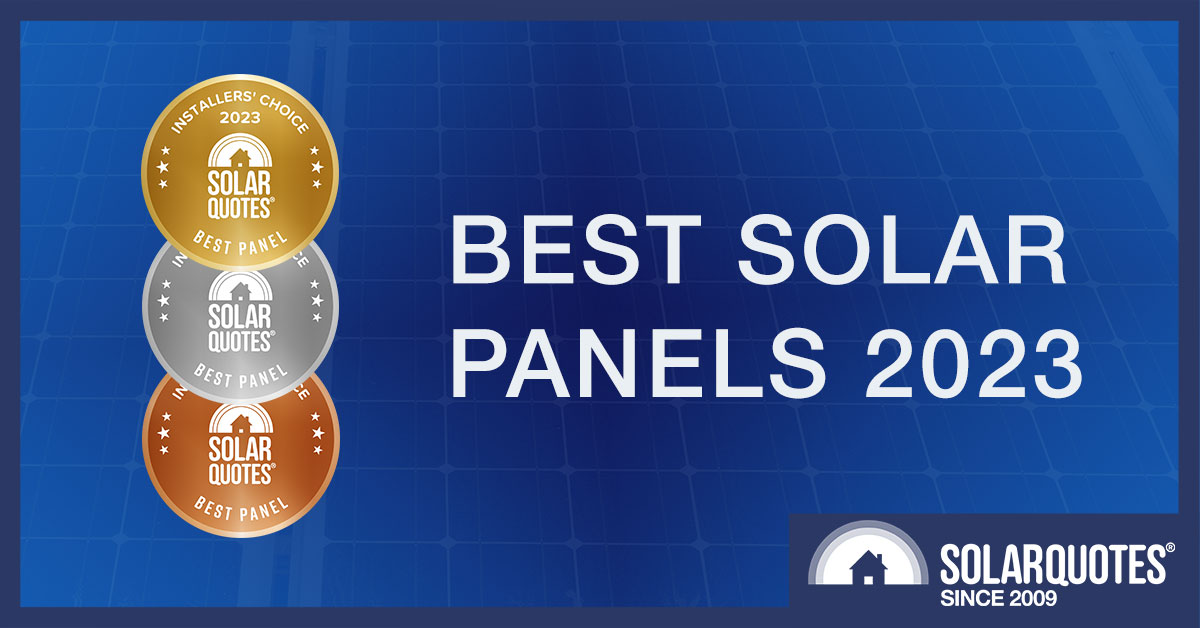
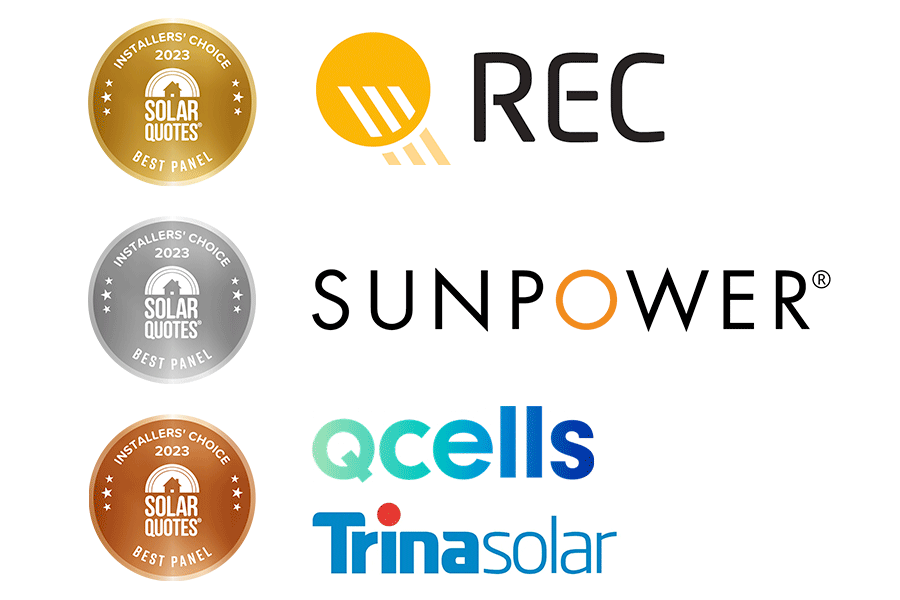
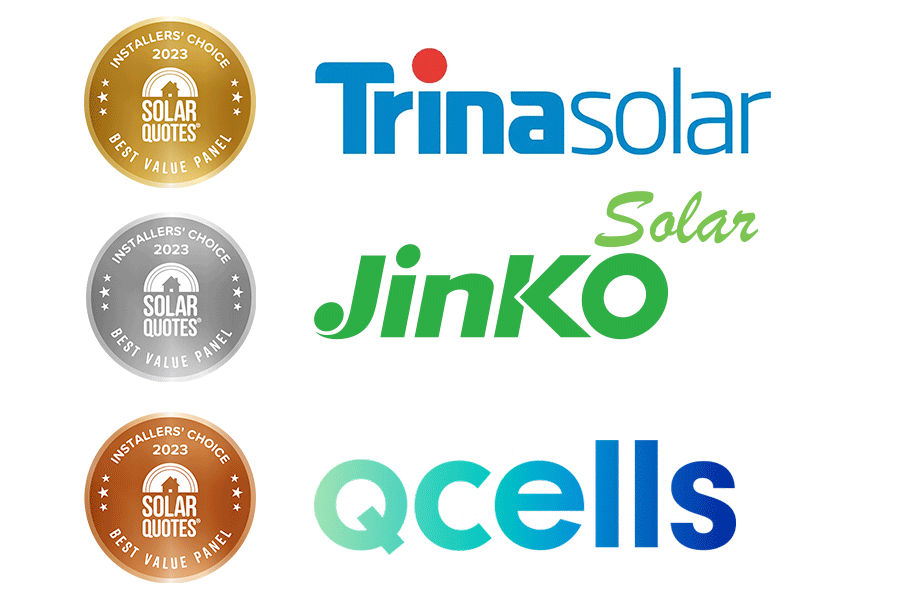
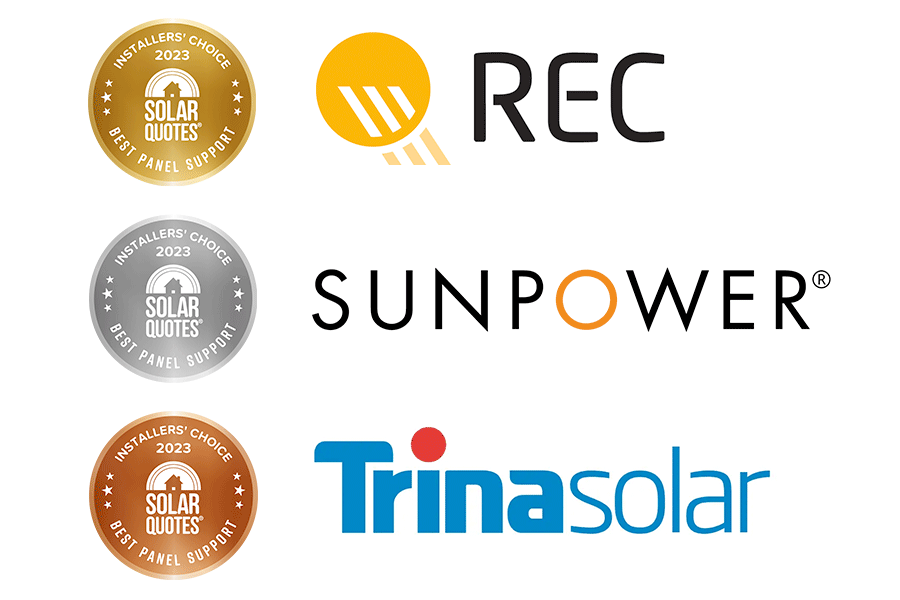
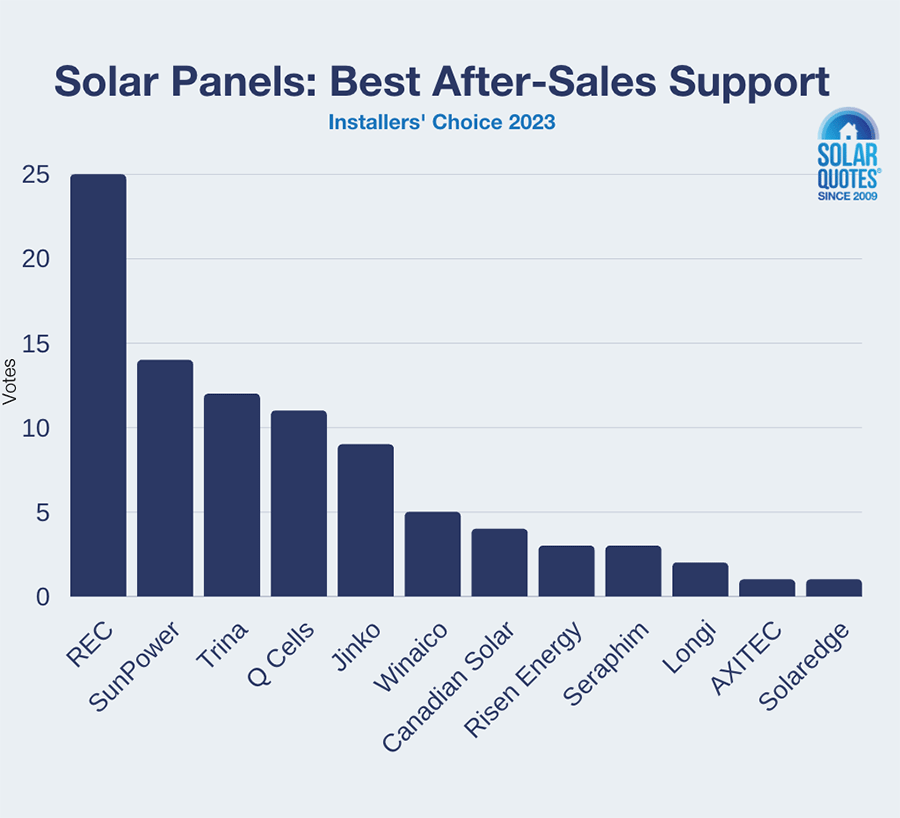
 RSS - Posts
RSS - Posts



What I would really like to know is where all kit is manufactured, and particularly what comes from China.
I see you have given that info for Q Cells and Trina but not others.
Last year I bought Sunpower Maxeon in the belief that they come from either the USA or Mexico but am not 100% confident this is accurate.
My reasoning is not one of quality but political. If China goes the same way as Russia any manufacturers guarantee will be worthless.
Doug,
REC is made in Singapore. Sunpower: different panels made in different countries.
You can find out where most panels sold in Australia are made on our Solar Panel Comparison Chart

Doug Pitney i went with Tindo too. An SA producer of panels. You can tour the factory if you want. They have info nights. Four years now and no problems. Started by people very concerned about environment initially, not just hopping on a business bandwagon as far as i understand. Installers were very good.
Phono solar panels are totally under rated
Wow, I have 10kW of REC Alpha Pure 400W panels on my roof with SolarEdge 8.25kW inverter last August and shortly after that, they released Alpha Pure R series.
Anyway, my REC Alpha Pure PV exceeded my expectation. Even in the most overcast days, it still diligently harvest minimum rate @ 1.9-2.0kW. In December, the inverter hit max from 11:30am to 3:00pm. The estimation from the installer was 59.3kW max but the actual highest production ever was 74.4kWh in December 2022, which is 125% more than maximum estimation from the installer.
SunPower was also on one of the quotes but I shrugged it off because it was ridiculously expensive. In the end, I paid a bit more for REC (than for Q cells as quoted) but I think it was the right decision. It’s still almost brand new, so I’ll watch to see if it degraded significantly in the next few years.
Also, I’ve found that the panels are having a fair bit of bird drops. Should I clean them Finn? And should I clean with some solvent like this?
https://birdcontrolaustralia.com.au/shop/residential-bird-deterrent/bird-dropping-cleaner-ready-to-use/
Thanks,
If you’ve got bird poo on your panels and the rain is not washing it off – they will need a clean. This post, written by our in-house installer, Anthony talks about bird-proofing:
https://www.solarquotes.com.au/blog/bird-proofing-solar-panels/
In my experience, you don’t need special solvents to clean your panels. This video from our friends at MC Electrical gives great cleaning tips.
How much difference does it make if say we choose one of usual top 5 solar panels brands? I am not talking about cheap stuff, is the price difference justify the potential minor increase in generation (If any)?
From what i have read, Inverter does all the heavy lifting and there is more to gain by investing more money in them rather than panels.
Basically i am just trying to ask, If Decent solar panels + Premium inverter (Say Fronius) will more or less generate same as Premium solar panels with Some other inverter?
Hi Vivek
You can expect premium quality panels to generate modestly more energy over time when compared to reliable lower cost panels. A small amount of this can be due to higher quality panels suffering lower losses from heat and other effects due to how they’re constructed. But generally, most of the advantage comes from slower deterioration in output over time. If, after 25 years, premium quality panels are at 94% of their original output while lower cost ones are at 84% then the premium panels would have generated around 5% more energy over that time. If their quality construction allows them to generate slightly more in addition to that it might come to a total of around 7% more. So if you are on a budget you are better off buying lower cost panels and getting a larger system. But if you want a high quality system that is very reliable and will generate a little more kilowatt of panel capacity, then you may consider premium panels to be worthwhile.
Fair enough! That does make sense, So over longer run it makes more of the difference
I bought Tindo Solar panels 3 years ago and have had no regrets. I wanted to buy Aussie and was willing to pay extra.
I was pleasantly surprised that it did not cost that much more to support an excellent Aussie business. They have good processes in place so installation went without a hitch. The gear that turned up was exactly what I paid for.
No point whinging about manufacturing dying out in Aus when we go buying Chinese stuff when a good local product is available.
I agree with you. Had Tindo Solar Panels and Solar Edge Inverter installed Jan 2022. Firstly, highly impressed initially when speaking to Tindo Solar in South Australia. Then, have to say that the team the installation company sent me were the the best tradies I have ever dealt with in my life. I have only come across one company that will quote on Tindo (ALS Solar and that is who I used), so that probably accounts for the survey result if based on Aussie Installers. I had quotes from about 6 installers in the long run and they all recommended LG panels but shortly my Tindo install after LG announced they would no longer be manufacturing solar panels, so I felt that was a lucky escape. So, as I said, I’m with you and I can’t recommend either ALS Solar or Tindo Solar highly enough.
I always try and support Australia Made / Grown / Produced whenever possible. I didn’t know about Tindo Solar in SA, otherwise I would have purchased my panels from them.
All Solar Installers should be pushing Australia Made as an option.
Can Solar Quotes please highlight Australian Made solar panels, inverters, batteries, and any other relevant kit ? Maybe do an article on this ? Or have an Australian Made section on your web site ? Please also flag the items with a big “Australian Made” when doing reviews.
We need to support Australia Made / Grown / Produced so that people have jobs.
Hi Moose,
Have a look for Selectronic inverters, PowerPlus batteries, AERL solar regulators for a start.
Cheers for the idea.
Note the solar rebate is worth about 44c per watt
was this rebate to be added or deducted from your retail price per watt ??
Hi Stephen
The “solar rebate” is deduction from the price of the solar system. When you get a quote for a system the price will include this financial incentive.
I have 2 large trees next to my property. One at the northern end, one at the eastern end. My colourbond roof still gets a good 5 hours of sunshine in summer, less in winter. One installer said it’s still worth getting solar panels. Another installer said “don’t bother”. Who do I believe?
Hi Gill
I’m afraid only you can decide if it’s worthwhile. It will depend on what sort of payback period you are happy with. Solar systems generate most of their energy in the middle of the day and, while the amount will be greatly reduced, they still produce some energy when shaded which helps. So shade may not reduce the output by as much as you think. But if we assume the shade is very heavy, it might double the payback time. If an unshaded system where you are would normally take 5 years to pay for itself, it will take 10. If it was me, I’d go for it because I like solar. I’d also shift my consumption to the middle of the day to increase the benefit I get from solar when it’s output is high and reduce the payback time. Of course, I’d also look into if it was possible to get the trees trimmed.
First, a comment that I am not an installer!
My installation at home has overshadowing in the afternoon after 15:00.
I got around this by using a SolarEdge inverter & Optimisers. (Microinverters do the same job). I have panels facing E, W & North. I have way overpowered the inverters (normally abt 33%, mine is above 50% extra).
I suggest trying to trim the trees if possible, but otherwise Microinverters or S/E with Optimisers work fine with some overshadowing.
Hope that helps.
Under the right circumstances, optimizers can definitely help with shading. But I want to make clear there’s no magic bullet. Regardless of what’s done to minimize its impact, shade will always be bad for solar output.
As long as you are paying power bills, Getting solar will always be worth it. Payback period could be longer depending upon shade and kind of system you go for.
Lots of shade related knowledge that the industry has been following since few years feels outdated now With higher efficient panels & great inverters.
I know couple of people who generates very good power even during heavy shading.
I have LG Neon 360w Panels 6.2k w/ Solaredge inverter battery. My question is will the LG panels be compatible with the REC 400W panels (we need to add more panels but LG are out of the game ?)
Hi Christine,
It will be more about optimiser compatibility than anything else. Have to find out what optimisers are there already and then choose whatever optimiser is needed to add to a string. There’s a table showing optimiser compatibility, they’ll have to look at that to work out what’s installed and what they are compatible with.
https://knowledge-center.solaredge.com/sites/kc/files/application_note_intercompatibility_se_power_optimizers.pdf
If they run out another string then just use whatever optimiser that suits the panels. Optimisers in different strings do not need to be compatible, but they need to work with the legacy inverter of course, and that may or not be eligible for more STCs depending on it’s age.
Basically you need accurate details of the system, serial numbers & model numbers and then get a SolarEdge installer to run through the options, bearing in mind that some SolarEdge stuff is hard to get at the moment and if they want to add a battery, that might need a different inverter anyway.
SE were offering some free upgrades on inverters with a battery purchase, and with extra STCs available once the battery option has been ticked, it might be worth throwing a fair amount more at it to get a lot more capacity… instead of just a bit more.
Let us know how you’d like to proceed, researching this answer turned up some new old stock LG 385w panels with one installer, there might be some lying about if you scrounge.
Cheers
We are a funny lot us Australians. China imposes draconian and totally unwarranted punitive tariffs on our key exports which, one way or another, has far reaching consequences for the ENTIRE economy and population; and what do we do? We roll over, accept it and keep buying in big numbers their cars, solar panels manufactured there and everything else you could imagine. We are on the ground, they are kicking us and we say ‘no probs, all good’. Our government wont impose reciprocal penalties on their products because we believe in a rules-based global trading order and in any case the PRC would go in even harder if we did. What we can do is vote with our wallets and buy products manufactured elsewhere; and our government can put its money where its mouth is and give meaningful support to Australian companies that are trying to reduce our supply-chain dependencies and who are trying to build (or rebuild) our manufacturing capability.
I see things differently. If China doesn’t buy our stuff, they’re the ones missing out. And we buy Chinese products if – and only if – we consider them worthwhile. If other countries offer better deals, we’ll buy from them. If Chinese Government action results in China buying less from us, we will invariably buy less from China because the only way they will be able to maintain the same volume while getting less from us is by lowering their prices, which is good for us. The real victims are Chinese citizens who can’t even vote out the people in charge when they get too stroppy.
Agree to disagree (and I won’t bug you with further responses ?). We buy Chinese products because they are cheap (child labour and slave labour significantly reduce the highest cost ‘factor of production’). No other reason. Game, set and match. That’s why MG cars are now in the top 10 sellers in Australia, beating higher quality offerings from trusted and popular companies such as Mitsubishi and Hyundai. And while all this is going on, China is buying its way into resource rich countries in West Africa and South America. Their iron ore and coal may not be as high a quality as Australia’s but its good enough and it reduces China’s dependence on our raw materials. They will lift their punitive tariffs on our raw materials (with great fanfare) after they have secured alternative suppliers and they will dangle crumb-size purchases in our faces as a sign of goodwill. Over and out.
“beating higher quality offerings from trusted and popular companies such as Mitsubishi and Hyundai” It would seem you have not taken a close look at an MG lately. The Chinese are the largest motor vehicle manufacturers in the world and the pace at which they utilise and improve technology is exponentially greater than many if not most big name manufacturers. You hold up Mitsubishi and Hyundai as shinning examples. Yet it wasn’t too many years ago when they were considered Jap junk and Korean crap. And whilst I admit I own both a Japanese (Nissan) and Korean (Ssangyong) vehicle, based on what I’ve experienced first hand, I’d be just as proud to own a Chinese made MG.
Our only locally made panel doesn’t even seem to get a mention? I have recently installed the Tindo 410w Karra panels and so far they seem good, and the installer found them good as well (although he grumbled about the width).
They are good but only produced in small numbers, which is probably why they didn’t make the cut.
I’ve looked at Tindo last year but the installer told me that we have to wait for months before Tindo is available for us. If Tindo were widely available, I would have gone with it.
I think there might have been some crossed messaging there. They had an older panel under production, and the newer one (what I got) wasn’t available yet. But I could have had mine delivered in September so I don’t think there was any issue with availability, rather just whether you were happy with the older panel or wanted to wait for the new ones.
I agree with Arny, the latest Sumec Phono bi-facial panels are amazing, yet they hardly get a mention, (as don’t so many other brands).
Trina and Jinko are high volume, reasonable quality budget (for the most part) suppliers. Do Trina and Jinko come so highly in recommended because they are so fantastic, or simply because of the number of installers that are selling them?
Most reasonable panels are very close in terms of their efficiency, NOCT, temperature ratingings and other technical figures, so close the differences are mostly irrelevant. There are however fairly big differences between standard panels vs bi-facials, or warranties, or how long the company has been making the panels, and supporting their product in Australia?
I have learnt so much by reading your blogs but I do feel your panel comparison chart is very limited and definitely not up to date. Articles like the one above are not nearly as informative as would appear. It’s not what is being said that’s the issue, it’s what’s not being said. Let’s not forget the industry is driven primarily by profit, so the opinions of installers and what they chose to sell might not be quite such as an objective, informative and definitive guide to this subject as the article title suggests. Supply, wholesale pricing and brand name market penetration probably have more to do with what installer chooses to sell than any other factor.
If I were a buyer doing google research, after reading this article I would come away with Trina or REC as the two top contenders and this is just so narrow. More helpful would be information on the latest technology, trends, green credentials of the manufacturer, does country of manufacture matter, pitfalls to avoid, warranties, etc. There are so many more good panels and manufacturers out there and so much more general information that could be conveyed to widen a buyers scope and knowledge base, rather than narrow it. (Sorry, I do like your other work).
Hi Tony
Our Recommended Panel Chart in our Solar 101 Guide…
https://www.solarquotes.com.au/solar101.html
…does a pretty good job of letting who are not familiar with solar know what are reliable panel brands that are well supported in Australia, along with their relative cost. Or at least it does in my opinion. It doesn’t go into differences in technology because in practical terms what matters to most homeowners is whether or not they work and if they’re reliable. It also doesn’t go into bifacial panels because they don’t provide a benefit for normal rooftop installations, but if a manufacturer on our Reccommended Chart makes a bifacial panel it’s likely to be reliable. That said, we do have more specific information in various places on our site that can be searched for.
So I buy supposedly very good panels in 2018 with a warranty of 20 years and 4 years later I find that they don’t even rate on your list.
Hi Jeff
These are panels chosen by installers. If they weren’t selected by them it doesn’t necessarily mean your panels aren’t on our recommended list of panels, which you can find in our Solar 101 Guide:
https://www.solarquotes.com.au/solar101.html
If they’re not there you can tell me which panels you have and I can let you know what I’ve heard about them, whether good or bad.
HI.Happy with my Sunpower Maxeon 6 435 Panels. As an example on 5th of February, which was a really sunny day they produced 94kWh. With North and West facing panels. I am now waiting for the release in Australia of the FRANKLIN 13.5 kWh Battery which is due to be realeased in May/June 2023. Maybe do a review of this battery.From what i have seen it seems to be very good. Regards Hans
Bit of a coincidence being the poll was installer based feedback but the 4 panels listed actually came out on top of my spreadsheet assessment based on technical data sourced from panel product data sheets (as of August 2022).
In order of total arguments (pros and cons, price excluded) were:
1st, Maxeon 6 (9/9)
2nd, Trina Vertex S plus 9//8 (width penalty)
3rd, REC Alpha Pure 8/8 (NOCT penalty which dropped a pro)
4th, Q cells 7/6 (Temp Co-eff & panel efficiency penalty)
I installed Trina S 415W as the Maxeon 6 price did not appear to be justifiable. 40 year warranty yes indicating quality of build but after 15 years if not before, panels made today will be well and truly superseded, regulations will likely have eased . . yeah maybe not, so what is to stop upgrading after 15 years if the ROI is only 7 years typical.
Excellent point.
may I suggest:
Add an extra panel to get your system output back up to your needs if your system output degrades.
No removal costs
No tip fees.
No new panel costs
No new installation costs.
That extra panel could be with its own micro inverter and feed directly into your home.
Some people say your existing inverter and the old panels may not be compatible.
I say that an installer, given the opportunity to put in a full system, would be biased.
Many ‘rabbit on” about a wave of polluting tips full of old panels.
I say keep your roof shaded. And add to the shading from your rooftop panels.
Finn thanks for this very useful information on Panels and Inverters. I bought LG panels and enphase inverters 2 years ago. Going well. What’s happened to LG? I dont see them in your survey.
Thanks Bill
Hi Bill, Ronald here.
I’m afraid LG has moved out of the solar panel business. Almost everyone was surprised by this and didn’t see it coming. The good news is LG is still supporting all their panels. They have a big warehouse full of replacements if they’re required. Fortunately, if you have LG panels on your roof you are very unlikely to need any replacements, as they are very reliable. LG is also a big company and not likely to disappear any time soon.
Am a little confused by your ratings for Trina v Qmax in
https://www.solarquotes.com.au/spottingadeal.html?gclid=CjwKCAiAu5agBhBzEiwAdiR5tNsh6B665t7M77bu9wkI0bB4p7S3Hesb8od2K7teNfcEqnih5itFsBoCEMoQAvD_BwE
The Trina S+ specs seem slightly better than the Qmax, the Trina seems slightly cheaper and is double sided glass so would expect a better mechanical performance. Can you tell me what I am missing in that comparison chart? Cheers
Hey Neil – our recommended brand chart sorts brands by price, not performance. If you check out our panel comparison table which lists prices, you’ll see that the difference in price between the Vertex S+ and the QMAXX is pretty decent: https://www.solarquotes.com.au/panels/comparison/compare-solar-panels/
Thanks Jonathan. I wouldnt expect you to update this as specs change but already the Jinko Tiger efficiency and annual degradation warranty are quite a bit better than it was when you did the review. For those interested these now 22.53% and .4% for 30 years for the JKM440N-54HL4-V Tiger Neo 440 Watt panels.
I also had 22 410W REC Alpha Pure R panels installed a couple of months ago. They weren’t my installers choice, they were my choice. Both the installer and I were so impressed by them, he has added them to his arsenal. They have our 10KWH (9.6) Sungrow battery fully charged by about 8.30 (in Brisbane) cloudy or clear skies. That is from about 50% discharge (we overestimated our nighttime power use. I’m very happy with REC!!!